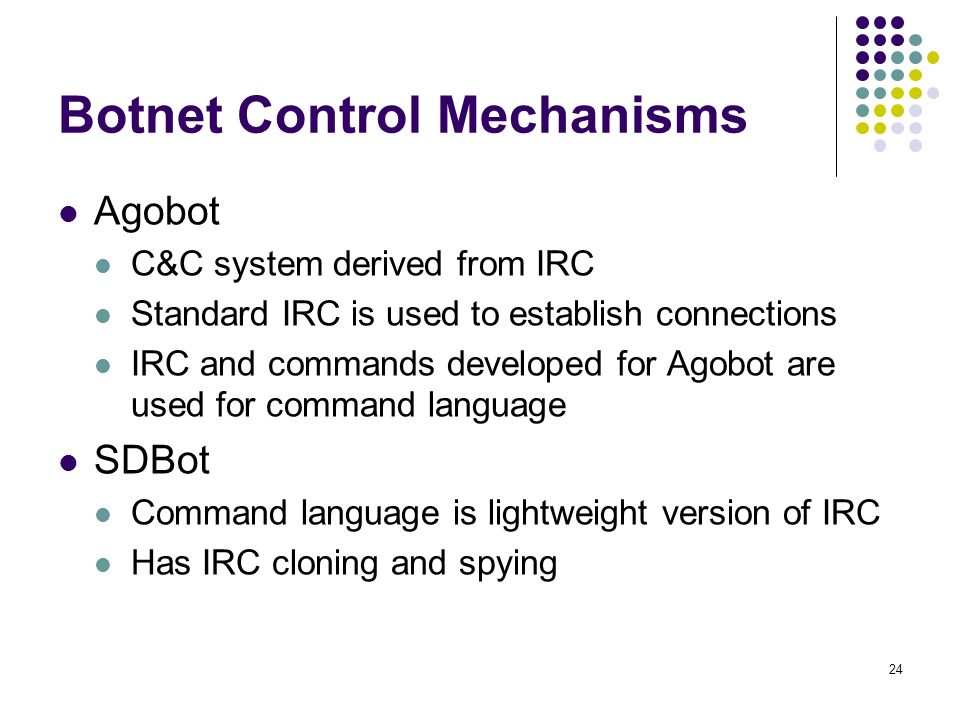

- #Agobot botnet command and control architecture update#
- #Agobot botnet command and control architecture software#
- #Agobot botnet command and control architecture free#
What’s worse, botnet design continues to evolve, making newer versions harder to find.īotnets take time to grow.

Users are unaware they’re connected device is being controlled by cyber criminals.
#Agobot botnet command and control architecture update#
More advanced botnets are even designed to update their behavior so as to thwart detection by cybersecurity software. They use only small amounts of computing power to avoid disrupting normal device functions and alerting the user. Such autonomous bots carry out seek-and-infect missions, constantly searching the web for vulnerable internet-connected devices lacking operating system updates or antivirus software.īotnets are difficult to detect. More complex botnets can even self-propagate, finding and infecting devices automatically.
#Agobot botnet command and control architecture free#
After infecting devices, botnets are then free to access and modify personal information, attack other computers, and commit other crimes.
#Agobot botnet command and control architecture software#
The strategy typically requires users to infect their own systems by opening email attachments, clicking on malicious pop up ads, or downloading dangerous software from a website. Bot herders often deploy botnets onto computers through a trojan horse virus.

Botnet Infectionsīotnets aren’t typically created to compromise just one individual computer they’re designed to infect millions of devices. Such an attack is called a denial of service or DDoS. They command their infected bot army to overload a website to the point that it stops functioning and/or access is denied. The simultaneous influx of such a large number of signals, pings, and requests would overload the DMV’s phone system, likely shutting it down completely.Ĭybercriminals use botnets to create a similar disruption on the internet. Now, imagine you wrangled 100 of your friends, to do the same thing. Aside from the deafening sounds of ringing phones and the scurrying of State employees, not much else would happen. Imagine the following: You’ve enlisted ten of your friends to call the Department of Motor Vehicles at the same time on the same day. The criminal’s ultimate goal is often financial gain, malware propagation, or just general disruption of the internet. The bigger the botnet, the bigger the impact. The more bots connected, the bigger the botnet. To build a botnet, botmasters need as many infected online devices or “bots” under their command as possible. The cyber criminals controlling them are called botmasters or bot herders. In a broad sense, that’s exactly what botnets are: a network of robots used to commit cyber crime. To better understand how botnets function, consider that the name itself is a blending of the words “robot” and “network”. It’s clear botnets are bad, but what are they exactly? And how can you protect your personal information and devices? Step one is understanding how bots work. It’s predicted the trend will continue, resulting in more computers infected with mining software and more digital wallets stolen.Īside from being tools for influencing elections and mining cryptocurrencies, botnets are also dangerous to corporations and consumers because they’re used to deploy malware, initiate attacks on websites, steal personal information, and defraud advertisers. The use of botnets to mine cryptocurrencies like Bitcoin is a growing business for cyber criminals. Recently published studies from MIT have concluded that social media bots and automated accounts play a major role in spreading fake news. Facebook’s fake ad controversy and the Twitter bot fiasco during the 2016 presidential election worry many politicians and citizens about the disruptive potential of botnets. Their growing popularity among cybercriminals comes from their ability to infiltrate almost any internet-connected device, from DVR players to corporate mainframes.īotnets are also becoming a larger part of cultural discussions around cyber security. Botnets have become one of the biggest threats to security systems today.


 0 kommentar(er)
0 kommentar(er)
